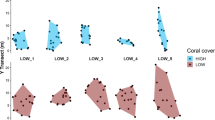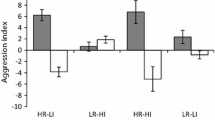Abstract
Functional responses describing how foraging rates change with respect to resource density are central to our understanding of interspecific interactions. Competitive interactions are an important determinant of foraging rates; however, the relationship between the exploitation and interference components of competition has received little empirical or theoretical consideration. Moreover, little is known about the relationship between aggressive behavioural interactions and interference competition. Using a natural gradient of consumer and resource densities, we empirically examine how aggressiveness relates to consumer–consumer encounter rates and foraging for four species of Chaetodon reef fish spanning a range of dietary niche breadths. The probability of aggression was most strongly associated with both total consumer and resource densities. In contrast, total encounter rates were best predicted by conspecific consumer density, and were highest for the most specialised consumer (Chaetodon trifascialis), not the most aggressive (Chaetodon baronessa). The most specialised consumer, not the most aggressive, also exhibited the largest reduction in foraging rates with increasing consumer density. Our results support the idea of a positive link between the exploitation and interference components of competition for the most specialised consumer. Moreover, our results caution against inferring the presence of ecological interactions (competition) from observations of behaviour (aggression and agonism) alone.



Similar content being viewed by others
References
Abrams PA (2015) Why ratio dependence is (still) a bad model of predation. Biol Rev 90:794–814. doi:10.1111/brv.12134
Abrams PA, Ginzburg LR (2000) The nature of predation: prey dependent, ratio dependent or neither? Trends Ecol Evol 15:337–341
Adams ES (2001) Approaches to the study of territory size and shape. Annu Rev Ecol Syst 277–303
Aljetlawi AA, Sparrevik E, Leonardsson K (2004) Prey–predator size-dependent functional response: derivation and rescaling to the real world. J Anim Ecol 73:239–252
Arditi R, Ginzburg LR (1989) Coupling in predator-prey dynamics: ratio-dependence. J Theor Biol 139:311–326
Beddington JR (1975) Mutual interference between parasites of predators and its searching efficiency. J Anim Ecol 44:331–340
Berumen ML, Pratchett MS (2006) Effects of resource availability on the competitive behaviour of butterflyfishes (Chaetondontidae). In: Proceedings of the 10th international coral reef symposium, pp 644–650
Blowes SA, Pratchett MS, Connolly SR (2013) Heterospecific aggression and dominance in a guild of coral-feeding fishes: the roles of dietary ecology and phylogeny. Am Nat 182:157–168
Burnham KP, Anderson DR (2002) Model selection and multi-model inference: a practical information-theoretic approach. Springer, New York
Case TJ (2000) An illustrated guide to theoretical ecology. Oxford University Press, Oxford
Chesson P (2000) Mechanisms of maintenance of species diversity. Annu Rev Ecol Syst 31:343–366
Cole AJ, Pratchett MS, Jones GP (2008) Diversity and functional importance of coral-feeding fishes on tropical coral reefs. Fish Fish 9:286–307
DeAngelis DL, Goldstein RA, O’Neill RV (1975) A model for trophic interaction. Ecology 56:881–892
DeLong JP, Vasseur DA (2011) Mutual interference is common and mostly intermediate in magnitude. BMC Ecol 11:1
DeLong JP, Vasseur DA (2013) Linked exploitation and interference competition drives the variable behavior of a classic predator–prey system. Oikos 122:1393–1400
Feinsinger P (1976) Organization of a tropical guild of nectarivorous birds. Ecol Monogr 46:257–291
Fletcher QE et al (2010) The functional response of a hoarding seed predator to mast seeding. Ecology 91:2673–2683
Fryxell JM, Lundberg P (1998) Individual behavior and community dynamics. Chapman & Hall, London
Graham MH (2003) Confronting multicollinearity in ecological multiple regression. Ecology 84:2809–2815
Harmelin-Vivien ML, Bouchon-Navaro Y (1983) Feeding diets and significance of coral feeding among chaetodontid fishes in Moorea (French Polynesia). Coral Reefs 2:119–127
Hassell MP, Varley GC (1969) New inductive population model for insect parasites and its bearing on biological control. Nature 223:1133–1137
Irons D (1989) Temporal and areal feeding behavior of the butterflyfish, Chaetodon trifascialis, at Johnston Atoll. Environ Biol Fishes 25:187–193
Lima SL, Dill LM (1990) Behavioral decisions made under the risk of predation: a review and prospectus. Can J Zool 68:619–640
Maher CR, Lott DF (2000) A review of ecological determinants of territoriality within vertebrate species. Am Midland Naturalist 143:1–29
McCullagh P, Nelder JA (1989) Generalized linear models. Chapman & Hall/CRC, London
Myrberg AA Jr, Thresher RE (1974) Interspecific aggression and its relevance to the concept of territoriality in reef fishes. Am Zool 14:81–96
Park T (1954) Experimental studies of interspecies competition II: temperature, humidity, and competition in two species of Tribolium. Physiol Zool 27:177–238
Peiman KS, Robinson BW (2010) Ecology and evolution of resource-related heterospecific aggression. Q Rev Biol 85:133–158
Pratchett MS (2007) Dietary selection by coral-feeding butterflyfishes (Chaetodontidae) on the Great Barrier Reef, Australia. Raffles Bull Zool 14:155–160
Pratchett MS, Berumen ML, Kapoor BG (eds) (2014) Biology of butterflyfishes. CRC Press, Boca Raton
Reese ES (1975) A comparative field study of the social behavior and related ecology of reef fishes of the family Chaetodontidae. Z Tierpsychol 37:37–61
Reese ES (1977) Coevolution of corals and coral feeding fishes of the family Chaetodontidae. In: Proceedings of the third international coral reef symposium, vol. 1, pp 267–274
Roberts CM, Ormond RFG (1992) Butterflyfish social behaviour, with special reference to the incidence of territoriality: a review. Environ Biol Fishes 34:79–93
Root RB (1967) The niche exploitation pattern of the blue-gray gnatcatcher. Ecol Monogr 37:317–350
Salt GW (1974) Predator and prey densities as controls of the rate of capture by the predator Didinium nasutum. Ecology 55:434–439
Siepielski AM, McPeek MA (2010) On the evidence for species coexistence: a critique of the coexistence program. Ecology 91:3153–3164
Skalski GT, Gilliam JF (2001) Functional responses with predator interference: viable alternatives to the Holling type II model. Ecology 82:3083–3092
Smallegange IM, van der Meer J, Kurvers RHJM (2006) Disentagling interference competition from exploitative competition in a crab-bivalve system using a novel experimental approach. Oikos 113:157–167
Stier A, White JW (2014) Predator density and the functional responses of coral reef fish. Coral Reefs 33:235
Turchin P (2003) Complex population dynamics: a theoretical/empirical synthesis. Princeton University Press, New Jersey
White JW, Samhouri JF, Stier AC, Wormald CL, Hamilton SL, Sandin SA (2010) Synthesizing mechanisms of density dependence in reef fishes: behavior, habitat configuration, and observational scale. Ecology 91:1949–1961
Whiteman EA, Cote IM (2004) Monogamy in marine fishes. Biol Rev 79:351–375
Wood S (2006) Generalized additive models: an introduction with R. CRC Press, Boca Raton
Wood SN, Scheipl F (2014) gamm4: generalized additive mixed models using mgcv and lme4. R package version 0.2–3. http://CRAN.R-project.org/package=gamm4
Wood SN, Scheipl F, Faraway JJ (2013) Straightforward intermediate rank tensor product smoothing in mixed models. Stat Comput 23:341–360. doi:10.1007/s11222-012-9314-z
Yabuta S, Kawashima M (1997) Spawning behavior and haremic mating system in the corallivorous butterflyfish, Chaetodon trifascialis, at Kuroshima Island, Okinawa. Ichthyol Res 44:183–188
Zuur AF, Ieno EN, Walker NJ, Saveliev AA, Smith GM (2009) Mixed effects models and extensions in ecology with R. Springer, New York
Acknowledgements
We thank James Cook University and the Australian Research Council for financial support; SAB was also supported by a Queensland Smart State Ph.D. fellowship. We thank E. Graham, S. Montanari, K. Nicolet, M. Norstad, and the staff of the Lizard Island Research Station for assistance in the field. We thank Craig Osenberg, Jeffrey Shima, and anonymous reviewers for constructive criticism that significantly improved this manuscript, and the JCU Ecological Modelling Research Group for support and feedback.
Author information
Authors and Affiliations
Contributions
SAB, MSP and SRC conceived and designed the research; SAB and MSP conducted the fieldwork; SAB analysed the data and wrote the first draft of the manuscript, and all authors contributed to revisions.
Corresponding author
Additional information
Communicated by Joel trexler.
Electronic supplementary material
Below is the link to the electronic supplementary material.
Rights and permissions
About this article
Cite this article
Blowes, S.A., Pratchett, M.S. & Connolly, S.R. Aggression, interference, and the functional response of coral-feeding butterflyfishes. Oecologia 184, 675–684 (2017). https://doi.org/10.1007/s00442-017-3902-8
Received:
Accepted:
Published:
Issue Date:
DOI: https://doi.org/10.1007/s00442-017-3902-8




